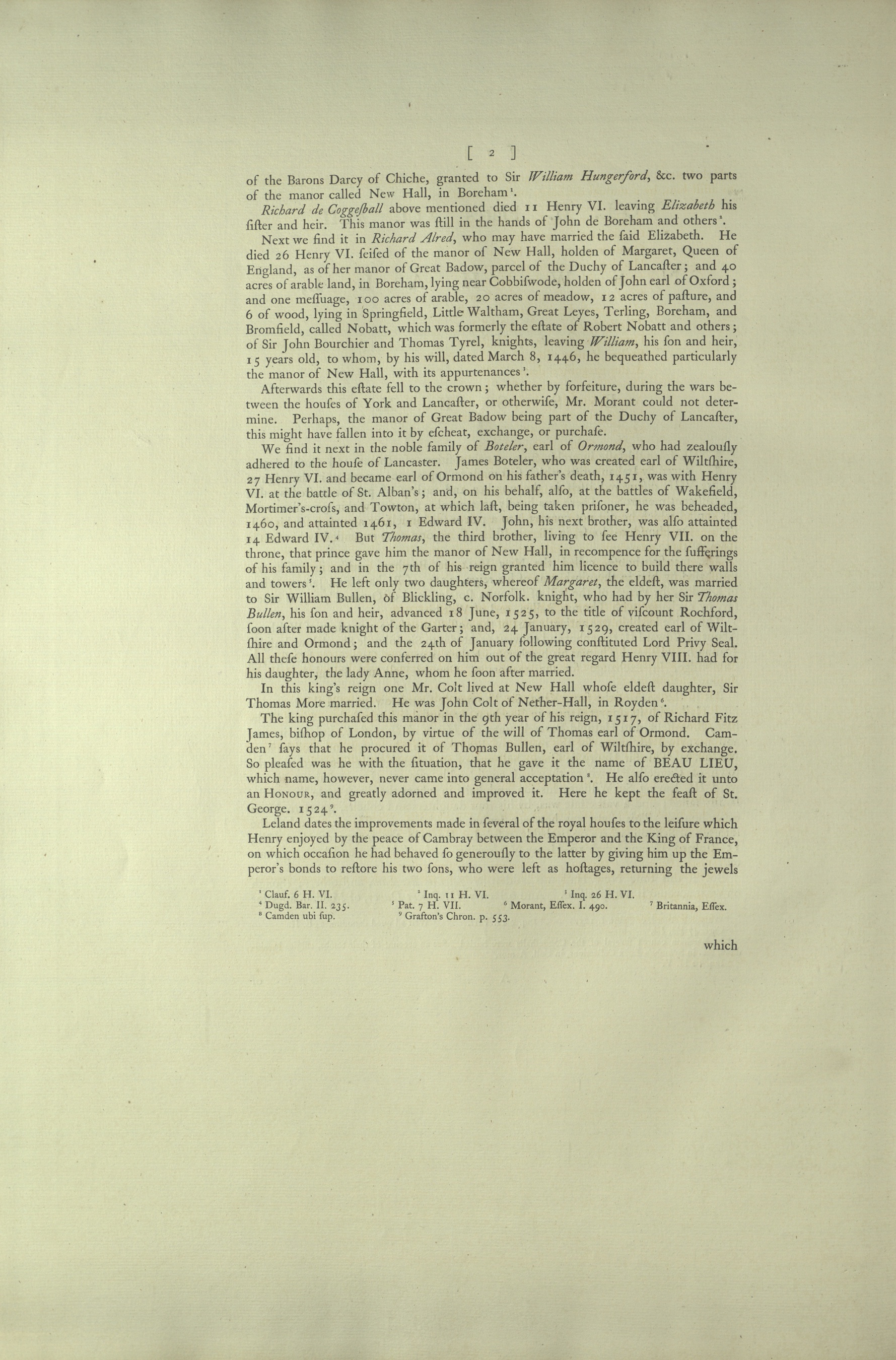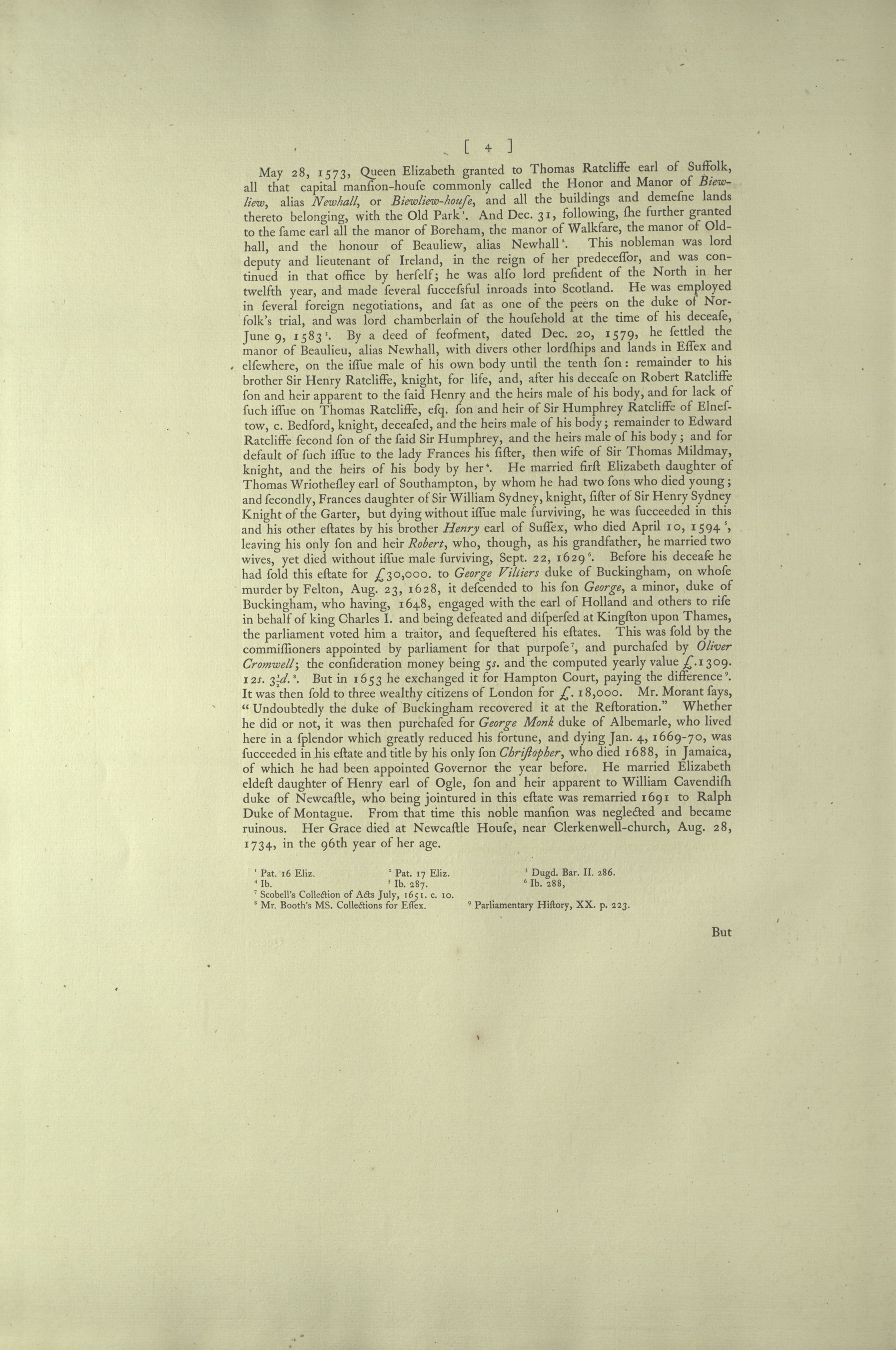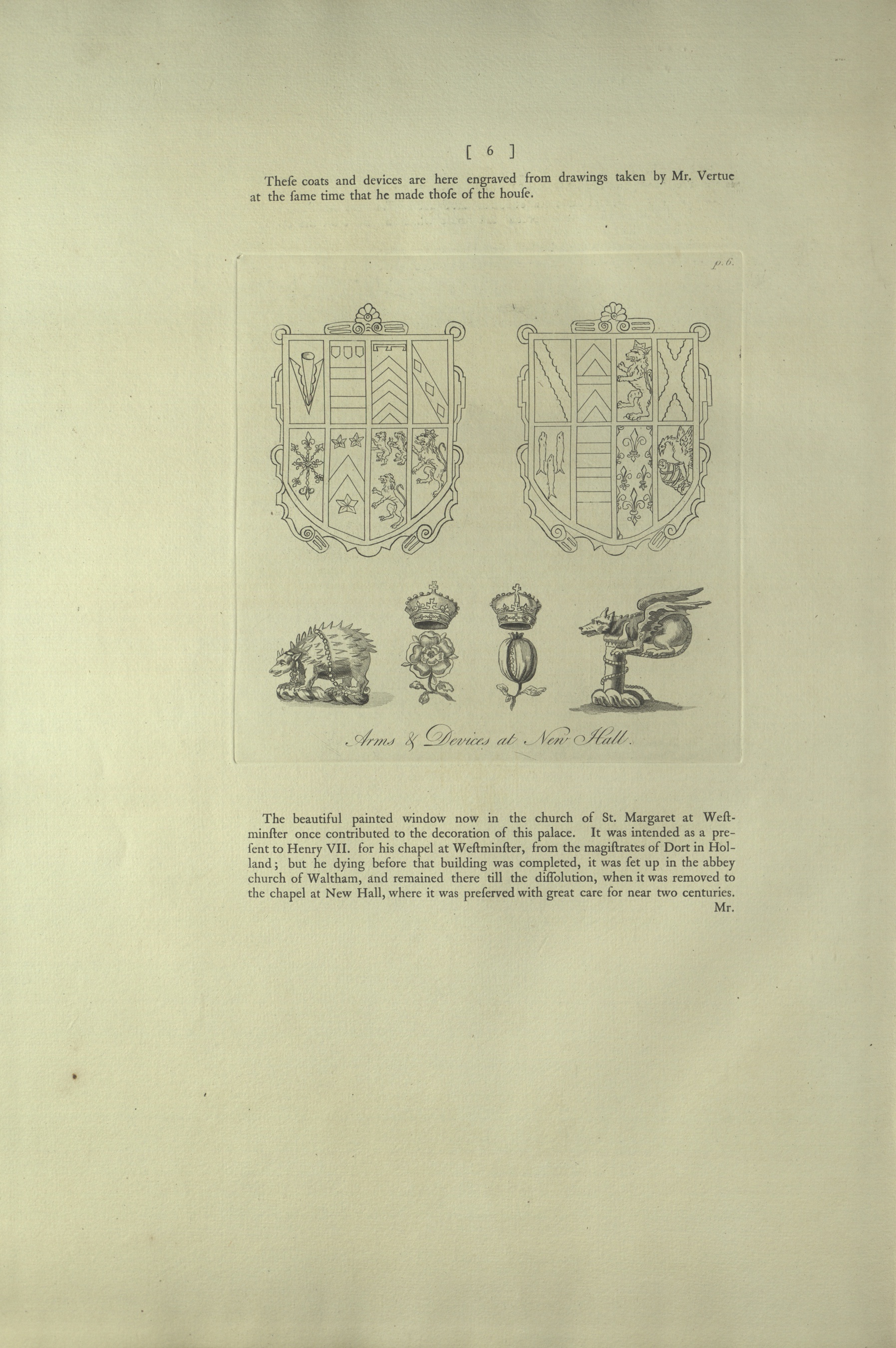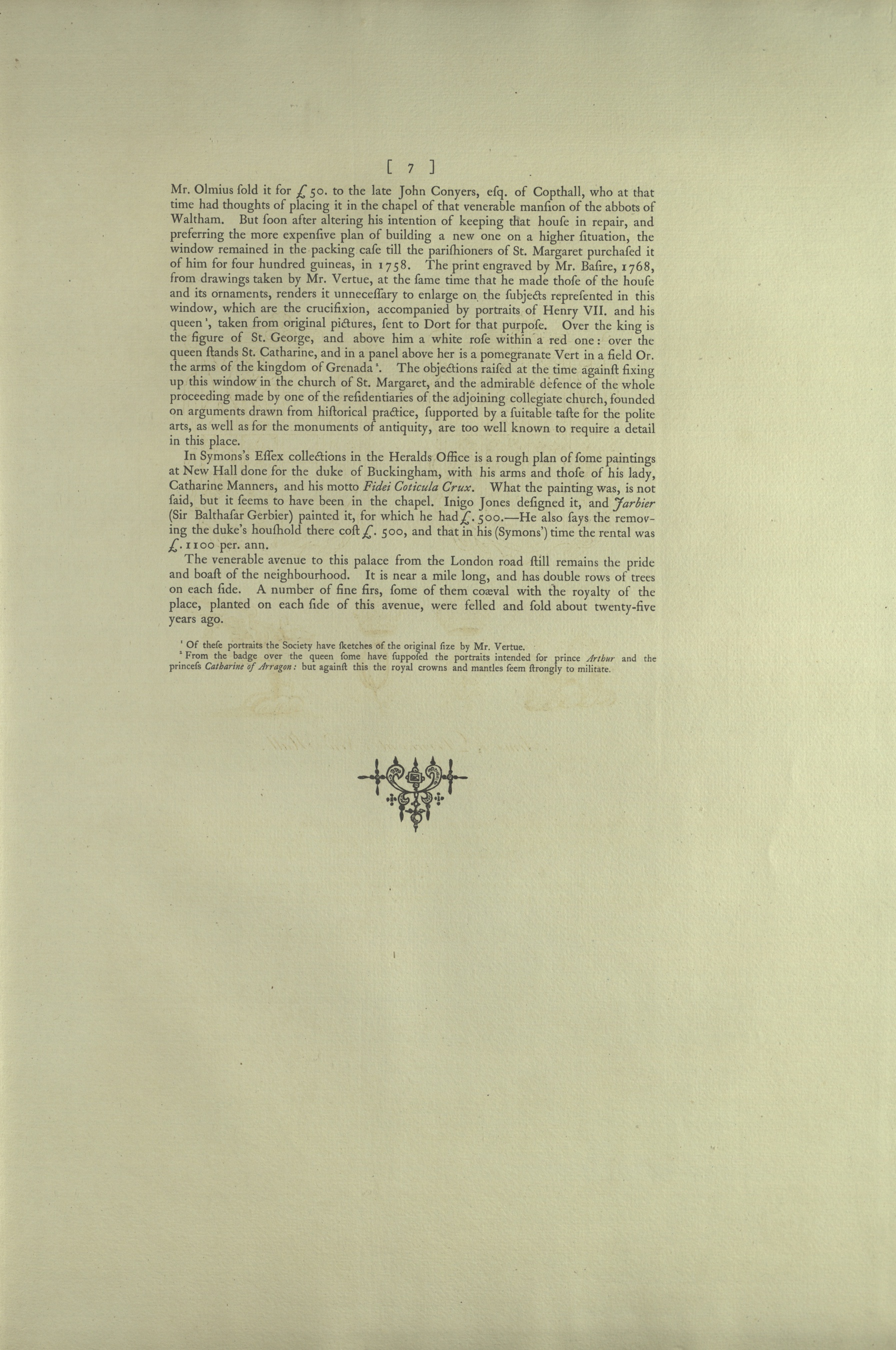
Creative Commons Attribution-Noncommercial-No Derivative Works 3.0
Plates 2.41-2.42: Palace of Beaulieu (Original Explanatory Account)
1 2020-06-27T11:32:47+00:00 Ariel Fried f6b6cec26c5a46c3beae9e3505bac9e8799f51de 31 15 Original Explanatory Account for Vetusta Monumenta, Plates 2.41-2.42. Written by Richard Gough. plain 2021-12-27T23:39:08+00:00 Mary-Claire Sarafianos b64b0f9cad2b567cca4c9f2022b28f5bd47876a6
[ (Page) 1 ]
VOL. II. Plates XLI. XLII.
NEW HALL, IN ESSEX.
THE splendid taste in architecture, a composition of Roman and Gothic introduced by Italian artists, which first made its appearance among us in the reign of Henry VIII. discovered itself in the number and variety of palaces erected by that magnificent monarch. There was hardly an agreeable situation within 30 miles round his capital which he did not convert into a palace for himself, or a nursery for his children. On Hunsdon-House, in Hertfordshire, £.19,000 were expended by him in the space of three years1.
The mansion-house, called the NEW HALL, in Boreham parish, in Essex, was purchased by him in the ninth year of his reign, 1517, of Richard Fitz James, bishop of London, by virtue of the will of Thomas Boteler, earl of Ormond2; or, as others say, by exchange with Thomas Bullen, earl of Wiltshire.
This noble lordship was antiently part of the possessions of the monastery of Waltham. About 24 Edward II. the abbot and convent granted it to Sir John of Shardelow, knight, Joanna his wife, and Thomas his brother, with their manors of Campes and Orseye, c. Cambridge, in exchange for the manors of Copped-Hall and Shingled-Hall, in Epping3.
But in the 47th of the same King, Sir Thomas de Shardelow granted this manor of New Hall, with its appurtenances in Boreham, Springfield, Little Badow, Little Waltham, Bromfield, and Hatfield Peverel, unto Sir Henry de Coggeshall, knight, in free and perpetual exchange for the manor of Bradeker, in Shropham and Holkham, c. Norfolk4. This Sir Henry de Coggeshall was of an antient family so named from the town of Coggeshall5, where they had considerable estates. He died about 49 Edward III. leaving Sir William, his son and heir, in whom the direct male line of the family failed; and a vast estate was, by his four daughters and coheirs, transferred into other houses. This estate was however settled on his brother Thomas, who had the lordship of Sandon, where he probably resided. He held the manor of New Hall, 15 Richard II. and died 10 Henry V.6 leaving Richard, his son and heir, 13 years old.
But at this time New Hall was holden by John de Boreham, and others; though on what account is not specified. And 6 Henry VI. Robert Darcy, of Malden, ancestor
2 Inq. 9 H. VIII.
3 Writ ad quod damnum [Writ to what damage], 24 E. II.
4 Cart. 47 Ed. III.
5 In Boreham church several of the Coggeshalls were buried. See an account of their tombs, effigiess in windows, &c. in Symons’s Essex Collection, in Coll. Armor.
6 Inq. 10 H. V.

[ (Page) 2 ]
of the Barons Darcy Of Chiche, granted to Sir William Hungerford, &c. two parts of the manor called in New Hall, in Boreham1.
Read more/less...
Richard de Coggeshall above mentioned died 11 Henry VI. leaving Elizabeth his sister and heir. This manor was still in the hands of John De Boreham and others2.
Next we find it in Richard Alred, who may have married the said Elizabeth. He died 26 Henry VI. seised of the manor of New Hall, holden of Margaret, Queen of England, as of her manor of Great Badow, parcel of the Duchy of Lancaster; and 40 acres of arable land, in Boreham, lying near Cobbiswode, holden of John earl of Oxford; and one messuage, 100 acres of arable, 20 acres of meadow, 12 acres of pasture, and 6 of wood, lying in Springfield, Little Waltham, Great Leyes, Terling, Boreham, and Bromfield, called Nobatt, which was formerly the estate of Robert Nobatt and others; of Sir John Bourchier and Thomas Tyrel, knights, leaving William, his son and heir, 15 years old, to whom, by his will, dated March 8, 1446, he bequeathed particularly the manor of New Hall, with its appurtenances3.
Afterwards this estate fell to the crown; whether by forfeiture, during the wars between the houses of York and Lancaster, or otherwise, Mr. Morant could not determine. Perhaps, the manor of Great Badow being part of the Duchy of Lancaster, this might have fallen into it by escheat, exchange, or purchase.
We find it next in the noble family of Boteler, earl of Ormond, who had zealously adhered to the house of Lancaster. James Boteler, who was created earl of Wiltshire, 27 Henry VI. and became earl of Ormond on his father’s death, 1451, was with Henry VI. at the battle of St. Alban’s; and, on his behalf, also, at the battles of Wakefield, Mortimer’s-cross, and Towton, at which last, being taken prisoner, he was beheaded, 1460, and attainted 1461, I Edward IV. John, his next brother, was also attainted 14 Edward IV.4 But Thomas, the third brother, living to see Henry VII. on the throne, that prince gave him the manor of New Hall, in recompense for the sufferings of his family; and in the 7th of his reign granted him licence to build there walls and towers5. He left only two daughters, whereof Margaret, the eldest, was married to Sir William Bullen, of Blickling, c. Norfolk. knight, who had by her Sir Thomas Bullen, his son and heir, advanced 18 June, 1525, to the title of viscount Rochford, soon after made knight of the Garter; and, 24 January, 1529, created earl of Wiltshire and Ormond; and the 24th of January following constituted Lord Privy Seal. All these honors were conferred on him out of the great regard Henry VIII. had for his daughter, the lady Anne, whom he soon after married.
In this king's reign one Mr. Colt lived at New Hall whose eldest daughter, Sir Thomas More married. He was John Colt of Nether-Hall, in Royden6.
The king purchased this manor in the 9th year of his reign, 1517, of Richard Fitz James, bishop of London, by virtue of the will of Thomas earl of Ormond. Camden7 says that he procured it of Thomas Bullen, earl of Wiltshire, by exchange. So pleased was he with the situation, that he gave it the name of BEAU LIEU, which name, however, never came into general acceptation8. He also erected it unto an HONOUR, and greatly adorned and improved it. Here he kept the feast of St. George. 15249.
Leland dates the improvements made in several of the royal houses to the leisure which Henry enjoyed by the peace of Cambray between the Emperor and the King of France, on which occasion he had behaved so generously to the latter by giving him up the Emperor’s bonds to restore his two sons, who were left as hostages, returning the jewels
2 Inq. 11. H. VI.
3 Inq. 26 H. VI.
4 Dugd. Bar. II. 235.
5 Pat. 7 H. VII.
6 Morant, Essex. I. 490.
7 Britannia, Essex.
8 Camden ubi sup.
9 Grafton’s Chron. p. 553.

[ (Page) 3 ]
which France had pawned to him, and forgiving him all the expences he had been at to assist him, by a mutual discharge on both sides1.
Read more/less...
Anglus tam placidae quietis autor
Gaudet munere pacis innovato:
Quoscunque artifices favens politos,
Hac lege ut laceros palatiorum
Muros restituant labore justo,
Conferantque suum novis nitorem.
Hinc crevit Viridis sinus2 corona;
Hundesdenaque pervenusta sedes;
Hinc BELLUS LOCUS extulit serenae
Frontis lumina, Brigidae et sacer Fons3,
Aedes magnifico decore festae.
Hinc Thornega4 vetus suos honores
Auxit splendida principum cathedra:
Shelfesega5 etiam domus renidens
Signis ventivolis et albicante
Crista. Sideris instar est Avona6,
Ottelandaque7 verticem alta tollit.
Et Nulli titulo8 domus secunda
Caelo quae caput inserit corusco9. [see end of document for translation]
Mr. Morant thinks it most probable that the old house here was either new built or repaired by Thomas, earl of Ormond. But it was greatly adorned and improved by Henry VIII. who built, in particular, the noble gate-house leading into the grand court, as appeared by his arms10 over the gate, carved in stone, supported by a lion and griffin, with this inscription under them:
henricus rex octavus, rex inclitus armis,
Magnanimus struxit hoc opus eximium11. [King Henry VIII, a king renowned in arms, nobly erected this outstanding work.]
They are said to have been brought from the gateway in one of the courts erected by this king, and are now over a door opposite the grand entrance, which door formerly lead into a spacious court12.
His daughter Mary, afterwards Queen of England, resided here some time13.
It received further improvement from Queen Elizabeth, who probably made it one of her retreats.
Over the house door were the arms of England as before, in a garter, supported by a crowned lion and a griffin sided by cariatides; over them this inscription.
VIVA ELIZABETHA. [Long live Elizabeth.]
Under the arms,
IN TERRA LA PIU SAVIA REGINA, EN CIELO LA PIU LUCENTA STELLA.
VIRGINE MAGNANIMA, DOTTA, DIVINA, LEGIADRA, HONESTA, E BELLA. [On earth the wisest Queen, in Heaven the brightest star / Noble, learned, divine, graceful, honourable, and fair virgin.]
2 Greenwich.
3 Bridewell.
4 Westminster.
5 Chelsea.
6 Hampton Court.
7 Oatlands.
8 Nonsuch.
9 Cygnea Cantio.
10 Quarterly, France and England, supported by a greyhound and griffin. A rose and pomegranate intertwined at bottom, and singly crowned over the head of each animal.
11 Symons gives it egregiū.
12 Of these two the Society have drawings, by Mr. Vertue.
13 Fox’s Book of Martyrs.

[ (Page) 4 ]
May 28, 1573, Queen Elizabeth granted to Thomas Ratcliffe earl of Suffolk, all that capital mansion-house commonly called the Honor and Manor of Biewliew, alias Newhall, or Biewliew-house, and all the buildings and demesne lands thereto belonging, with the Old Park1.
Read more/less...
And Dec. 31, following, she further granted to the same earl all the manor of Boreham, the manor of Walkfare, the manor of Oldhall, and the honour of Beauliew, alias Newhall2. This nobleman was lord deputy and lieutenant of Ireland, in the reign of her predecessor, and was continued in that office by herself; he was also lord president of the North in her twelfth year, and made several successful inroads into Scotland. He was employed in several foreign negotiations, and sat as one of the peers on the duke of Norfolk’s trial, and was lord chamberlain of the household at the time of his decease, June 9, 15833. By a deed of feofment, dated Dec. 20, 1579, he settled the manor of Beaulieu, alias Newhall, with divers other lordships and lands in Essex and elsewhere, on the issue male of his own body until the tenth son: remainder to his brother Sir Henry Ratcliffe, knight, for life, and, after his decease on Robert Ratcliffe son and heir apparent to the said Henry and the heirs male of his body, and for a lack of such issue on Thomas Ratcliffe, esq. son and heir of Sir Humphrey Ratcliffe of Elnestow, c. Bedford, knight, deceased, and the heirs male of his body; remainder to Edward Ratcliffe second son of the said Sir Humphrey, and the heirs male of his body; and for default of such issue to the lady Frances his sister, then wife of Sir Thomas Mildmay, knight, and the heirs of his body by her4. He married first Elizabeth daughter of Thomas Wriothesley earl of Southampton, by whom he had two sons who died young; and secondly, Frances daughter of Sir William Sydney, knight, sister of Sir Henry Sydney Knight of the Garter, but dying without issue male surviving, he was succeeded in this and his other estates by his brother Henry earl of Sussex, who died April 10, 15945, leaving his only son and heir Robert, who, though, as his grandfather, he married two wives, yet died without issue male surviving, Sept. 22, 16296. Before his decease he had sold this estate for £30,000. to George Villiers duke of Buckingham, on whose murder by Felton, Aug. 23, 1628, it descended to his son George, a minor, duke of Buckingham, who having, 1648, engaged with the earl of Holland and others to rise in behalf of king Charles I. and being defeated and dispersed at Kingston upon Thames, the parliament voted him a traitor, and sequestered his estates. This was sold by the commissioners appointed by parliament for that purpose7, and purchased by Oliver Cromwell; the consideration money being 5s. and the computed yearly value £.1309. 12s. 3½d.8. But in 1653 he exchanged it for Hampton Court, paying the difference9. It was then sold to three wealthy citizens of London for £.18,000. Mr. Morant says, “Undoubtedly the duke of Buckingham recovered it at the Restoration.” Whether he did or not, it was then purchased by George Monk duke of Albemarle, who lived here in a splendor which greatly reduced his fortune, and dying Jan. 4, 1669-70, was succeeded in his estate and title by his only son Christopher, who died 1688, in Jamaica, of which he had been appointed Governor the year before. He married Elizabeth eldest daughter of Henry earl of Ogle, son and heir apparent to William Cavendish duke of Newcastle, who being jointured in this estate was remarried 1691 to Ralph Duke of Montague. From that time this noble mansion was neglected and became ruinous. Her Grace died at Newcastle House, near Clerkenwell-church, Aug. 28, 1734, in the 96th year of her age.
2 Pat. 17 Eliz.
3 Dugd. Bar. II. 286.
4 Ib.
5 Ib. 287.
6 Ib. 288, [sic]
7 Scobell’s Collection of Acts July, 1651. c. 10.
8 Mr. Booth’s MS. Collections for Essex.
9 Parliamentary History, XX. p. 223.

[ (Page) 5 ]
But before her decease Benjamin Hoare, esq. youngest son of Sir Richard Hoare, banker in Fleetstreet, and Lord Mayor of London, 1713, had bought of her heirs the reversion of New Hall, and other estates appendant thereto.
Read more/less...
With the marble and other materials of this mansion he decorated the house which he built on the opposite or South side of the London road to Harwich. He died Jan. 12, 1749, leaving issue Richard. But before his death he sold New Hall, in 1737, with the gardens, park behind it, and the fine avenue (but none of the land on each side of it) to John Olmius, esq. who after tak[ing] down the more extensive appendages of this royal seat, fitted up the remaining part, including the great hall, above 40 feet high, 90 long, and 50 wide, for a residence for himself and successors, which his son has considerably improved. He married, 1741, Anne daughter and heiress of Sir William Billers, knight, Lord Mayor of London; was created, 1762, baron Waltham of Philipstown, in the kingdom of Ireland, and dying March 12, 1764, was succeeded by his eldest son Drigue-Billers Olmius, the second baron and present proprietor of this mansion, 1786.
Like Audley End, New Hall has been reduced from two courts to the central part, or the South side of the inner court, consisting of the great hall and apartments connected with it.
Over the door leading to the chapel are, or were, these arms and quarterings carved in stone of Thomas Ratcliffe earl of Sussex, with those of his lady Frances Sydney, daughter of Sir William Sydney of Penshurst in Kent, knt. the celebrated founderess of Sydney Sussex College, Cambridge, and whose time by these arms we may conclude some additions were made to this mansion:
1. A bend ingrailed. Ratcliffe earl of Sussex.
2. A fess between two chevrons. Fitzwalter.
3. A lion rampant crowned, within a bordure. Burnell.
4. A saltire ingrailed. Botetourt.
5. Three lucies hauriant. Lucy.
6. Three bars. Multon.
7. Semee Fleurs de lis. Mortimer of Attilborough.
8. An eagle and child. Culcheth.
Over the door leading to the hall those of Frances countess of Sussex, his consort:
1. A pheon. Sydney.
2. Two bars, in chief three shields. Clunford.
3. Three chevronells; a label of 3 points. Barrington.
4. On a bend three lozenges or muscles. Mercy.
5. Quarterly an escarbuncle. Mandeville.
6. A chevron between three mullets. Chetwynd.
7. Three lions rampant. Baard.
8. Barry of 8 a lion rampant crowned. Brandon.
A bear chained: the crest of Dudley earl of Leicester.
A griffin chained.
A rose crowned. Henry VIII.
A pomegranate crowned. Catharine of Arragon, his queen.

[ (Page) 6 ]
These coats and devices are here engraved from drawings taken by Mr. Vertue at the same time that he made those of the house.
Read more/less...
[An image is reproduced, the caption on the image:] Arms & Devices at New Hall.
The beautiful painted window now in the church of Saint Margaret at Westminster once contributed to the decoration of this palace. It was intended as a present to Henry VII. for his chapel at Westminster, from the magistrates of Dort in Holland; but he dying before that building was completed, it was set up in the abbey church of Waltham, and remained there till the dissolution, when it was removed to the chapel at New Hall, where it was preserved with great care for near two centuries.

[ (Page) 7 ]
Mr. Olmius sold it for £50. to the late John Conyers, esq. of Copthall, who at that time had thoughts of placing it in the chapel of that venerable mansion of the abbots of Waltham.
Read more/less...
But soon after altering his intention of keeping that house in repair, and preferring the more expensive plan of building a new one on a higher situation, the window remained in the packing case till the parishioners of St. Margaret purchased it of him for four hundred guineas, in 1758. The print engraved by Mr. Basire, 1768, from drawings taken by Mr. Vertue, at the same time that he made those of the house and its ornaments, renders it unnecessary to enlarge on the subjects represented in this window, which are the crucifixion, accompanied by portraits of Henry VII. and his queen1, taken from original pictures, sent to Dort for that purpose. Over the king is the figure of St. George, and above him a white rose within a red one: over the queen stands St. Catherine, and in a panel above her is a pomegranate Vert in a field Or. the arms of the kingdom of Grenada2. The objections raised at the time against fixing up this window in the church of St. Margaret, and the admirable defence of the whole proceeding made by one of the residentiaries of the adjoining collegiate church, founded on arguments drawn from historical practice, supported by a suitable taste for the polite arts, as well as for the monuments of antiquity, are too well known to require a detail in this place.
In Symons’s Essex collections in the Heralds Office is a rough plan of some painting at New Hall done for the duke of Buckingham, with his arms and those of his lady, Catharine Manners, and his motto Fidei Coticula Crux [The Cross, Touchstone of Faith]. What the painting was, is not said, but it seems to have been in the chapel. Inigo Jones designed it, and Jarbier (Sir Balthasar Gerbier) painted it, for which he had £.500.—He also says the removing the duke’s household there cost £.500, and that in his (Symons’) time the rental was £.1100 per. ann.
The venerable avenue to this palace from the London road still remains the pride and boast of the neighbourhood. It is near a mile long, and has double rows of trees on each side. A number of fine furs, some of them coaeval with the royalty of the place, planted on each side of this avenue, were felled and sold about twenty-five years ago.
2 From the badge over the queen some have supposed the portraits intended for prince Arthur and the princess Catharine of Arragon: but against this the royal crowns and mantles seem strongly to militate.
Translations of the Longer Passages:
Page 3, lines 2-19: The English author of calm repose takes joy in his gift of renewed peace, showing all skilled artisans his favor on this condition: that they rebuild the dilapidated walls of his palaces with just labor and confer a splendor of their own making to new ones. Herefrom has grown the crown of Viridis sinus (Greenwich), and the very charming seat of Hundesdena (Hunsden); herefrom Bellus Locus (Beaulieu) has lifted up the lights of its serene brow, as has hallowed Brigidae Fons (Bridewell), a festive residence of magnificent beauty. Herefrom venerable (Thornega) Westminster, illustrious seat of rulers, has added to its honors. Shelfesega (Chelsea) too, a home resplendent with banners blowing in the wind and its white crest. Like a star is Avona (Hampton Court), and Ottelanda (Oatlands) lifts its head aloft. And his home, second to none in name (Nonsuch), which inserts its head into the gleaming firmament.